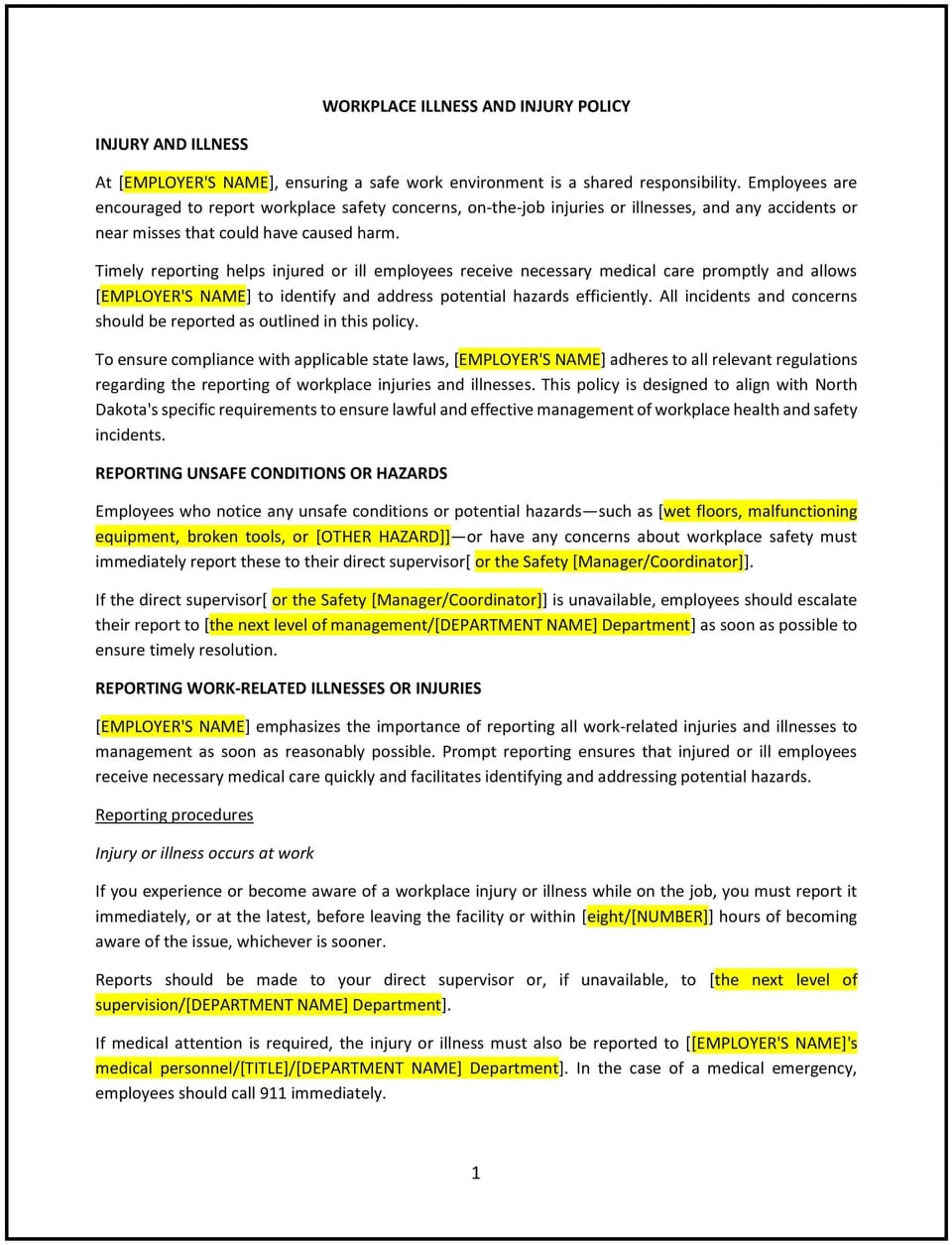Workplace illness and injury policy (North Dakota): Free template

Workplace illness and injury policy (North Dakota)
A workplace illness and injury policy helps North Dakota businesses manage and respond to employee illnesses and injuries that occur at work. This policy outlines the procedures for reporting, handling, and recovering from workplace injuries and illnesses, including guidelines for medical treatment, reporting requirements, and the use of workers’ compensation benefits. It is designed to create a safe and supportive environment for employees while ensuring that the business can manage incidents efficiently.
By adopting this policy, businesses in North Dakota can reduce the risk of workplace injuries, support affected employees, and improve compliance with state regulations.
How to use this workplace illness and injury policy (North Dakota)
- Define workplace injuries and illnesses: Clearly specify the types of illnesses and injuries covered by the policy, including physical injuries (e.g., slips, falls, and lifting injuries) and illnesses resulting from workplace hazards (e.g., exposure to chemicals or noise).
- Establish reporting procedures: Outline the process for employees to report injuries or illnesses as soon as they occur. Specify the timeframes for reporting incidents and the required documentation, such as accident reports or medical documentation.
- Provide medical treatment guidelines: Define the steps employees should take to seek medical treatment after an injury or illness. This may include visiting a designated healthcare provider or seeking treatment from any qualified provider. Address the use of workers' compensation for eligible injuries.
- Clarify leave and benefits: Specify whether employees will be paid for time off due to illness or injury and how workers' compensation benefits will be applied. The policy should also clarify the use of sick leave, PTO, or unpaid leave for time off due to workplace illness or injury.
- Implement return-to-work procedures: Outline the process for returning to work after an illness or injury, including any necessary medical clearances, modifications to job duties, or accommodations to help the employee transition back to full duties.
- Promote a safe work environment: Ensure that the policy includes measures for preventing workplace injuries and illnesses, such as safety training, hazard identification, and proper use of safety equipment.
- Review and update: Regularly review and update the policy to reflect changes in North Dakota state laws, workplace safety regulations, and the company's evolving needs.
Benefits of using this workplace illness and injury policy (North Dakota)
This policy provides several benefits for North Dakota businesses:
- Promotes employee safety and health: A clear and proactive approach to managing workplace illnesses and injuries helps reduce the risk of accidents and protects employees’ well-being.
- Supports injured employees: By outlining clear procedures for medical treatment, reporting, and leave, the policy ensures that employees who experience illness or injury are properly supported during their recovery.
- Reduces liability: A well-documented illness and injury policy helps businesses manage workers’ compensation claims and reduces the risk of legal action related to workplace injuries.
- Increases employee satisfaction: Offering clear guidance on leave and recovery procedures helps employees feel supported and valued, improving morale and engagement.
- Enhances operational efficiency: Having a consistent policy in place helps businesses quickly respond to illness or injury incidents, minimizing disruptions to operations.
Tips for using this workplace illness and injury policy (North Dakota)
- Communicate the policy clearly: Ensure that all employees are aware of the workplace illness and injury policy, including how to report incidents and access medical treatment. The policy should be included in employee handbooks and reviewed during onboarding.
- Encourage safe practices: Promote workplace safety by offering regular training, safety equipment, and encouraging employees to report unsafe conditions. Preventing accidents in the first place is key to reducing injuries.
- Track injuries and illnesses: Keep accurate records of all incidents to help identify patterns, ensure compliance with workers' compensation, and analyze trends to improve workplace safety.
- Follow up with injured employees: Stay in contact with employees who are off work due to illness or injury to ensure they are recovering well and provide assistance with their return-to-work process.
Q: Why should North Dakota businesses adopt a workplace illness and injury policy?
A: Businesses should adopt this policy to protect employees, promote a safe work environment, and manage workplace injuries and illnesses efficiently. It also helps comply with North Dakota state laws and reduces the risk of legal action.
Q: What types of injuries and illnesses are covered under this policy?
A: The policy covers injuries or illnesses that occur while performing work-related duties, including physical injuries (e.g., accidents) and illnesses resulting from exposure to workplace hazards (e.g., chemicals or noise).
Q: Is paid time off provided for illness or injury?
A: The policy should specify whether illness or injury leave is paid or unpaid. It may also include provisions for workers' compensation and how it impacts paid leave, PTO, or sick leave.
Q: How should employees report workplace injuries or illnesses?
A: Employees should report injuries or illnesses to their supervisor or HR department immediately, following the procedures outlined in the policy. The company should specify the time frame for reporting and any required documentation.
Q: What happens if an employee is not following the policy?
A: If an employee is not following the policy, businesses should address the issue according to their internal procedures, which may include counseling, further training, or disciplinary action, depending on the severity of the situation.
Q: How often should businesses review their workplace illness and injury policy?
A: Businesses should review their workplace illness and injury policy annually or whenever there are significant changes in regulations, workplace conditions, or company operations to ensure that it remains up-to-date and effective.
This article contains general legal information and does not contain legal advice. Cobrief is not a law firm or a substitute for an attorney or law firm. The law is complex and changes often. For legal advice, please ask a lawyer.


